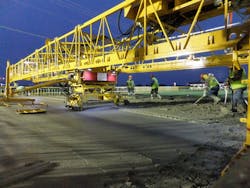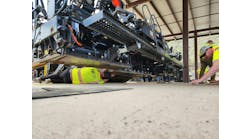Progress sometimes comes at a price.
Take for instance the interchange where Old Windthorst Road and Highways 82 and 287 meet in Wichita Falls, Texas. When the turnaround bridge at this interchange was constructed in 1964, low traffic counts and nonexistent development in the area prompted Texas Department of Transportation officials to construct a two-lane bridge.
After nearly 50 years of progress, this two-lane bridge could no longer withstand the high traffic counts and was functionally obsolete to say the least. Significant neighborhood development now blankets the once rural area, pushing vehicle traffic well beyond what was ever imagined a half-century ago. Jack Grayson, project superintendent for the Lane Construction Corp.’s Fort Worth, Texas, office further explained, “a couple of truck stops were also built near this interchange, which congested the area with truck traffic and did not leave enough room for trucks to easily maneuver.”
In January 2011, the Texas DOT began to design a new bridge that would replace the Old Windthorst Road Bridge relic with a modern structure designed to handle current traffic loads and those well into the future. Heavy civil contractor Lane Construction was awarded a $2.7 million project that required the removal of the existing span over Highways 82 and 287 and replacement with the more modern, wider and safer structure.
This is where the double-sided coin of progress helped the contractor. Lane Construction used a new integrated LED lighting system developed by Terex for Terex Bid-Well paving equipment, which helped finishers produce a higher-quality deck surface during the nighttime paving hours.
The new bridge measured 56 ft wide by 270 ft long. It was designed to carry four lanes of traffic, two in each direction, and it included eastbound and westbound turn lanes to make it easier for truck traffic and ease congestion.
The new bridge consisted of a slab-over-panel design to better withstand the volume of heavy truck traffic. During bridge construction, the old bridge remained in place, making it tight for construction and paving. “We had only about 12 in. of clearance between the two bridges,” said Grayson.
Bridge construction included short tub beams to add strength to the structure. “This is designed to be a 100-year bridge,” added Grayson.
For the bridge’s deck, Lane Construction’s crews used 360 cu yd of Class S, 4,500-psi concrete. The Texas DOT required that deck paving be completed during the nighttime hours. Grayson explained the reasoning. “First, the highway below the deck had to be closed to traffic, so if concrete were spilled during paving it wouldn’t drop onto a vehicle, and second, the heat of the day can make the concrete set too quickly.”
While there are several benefits to nighttime paving, it also comes with some drawbacks. One major issue is lighting the area so the finishers can see the surface. “The tower lights used to light the entire jobsite cause significant shadowing over the bridge deck, which makes it difficult for the finishers to see what they are doing,” said Larry Eben, district manager for Terex Bid-Well equipment.
To reduce the shadows cast by tower lighting, Grayson and Lane Construction’s paving crew would mount a small generator to the truss frame of their Terex Bid-Well 4800 paver. Five or six extension cords would then connect the generator to the halogen lights mounted at several positions on the paver’s frame.
While these lights helped the situation, there were a few drawbacks to this solution. “The generator required extra gas, and it took time for our crews to run the extension cords,” said Grayson. “If the halogen lights were mounted too far from the end of the paver, it would still throw shadows.”
To mitigate the inconvenience of this homemade lighting solution, Lane Construction recently ordered a paver with a new lighting system specially designed to work with the paver for nighttime applications.
The new paver with the integrated light kit was initially ordered for a paving project on I-35 near Fort Worth, Texas. However, engineering delays on that project made the Wichita Falls bridge project ready for paving first. “We simply reconfigured the paver and light system for the Old Windthorst Road Bridge project,” said Eben. “It goes to show the flexibility of both the paver and the light system.”
For paving the five traffic and turn lanes on the bridge, Lane Construction set its paver to a width of 70 ft. A total of eight new patent-pending LED lights were used to light the paver, concrete surface and paving carriage. “We positioned two lights at each end of the paver and four to illuminate the paving carriage,” said Javier Valencia, Terex Bid-Well equipment service representative. The two at each end of the paver helped the finishers to seal the edges, while the four on the paving carriage allowed crews to see the finished surface.
The new LED light system is fully integrated into the paver and powered directly by the paver’s two engines, eliminating the need for and extra expense of a generator. The sealed 5-in.-diam., 12-volt lights draw only one amp of power yet contain 13 LED lights that flood a broad area with bright light. Up to 12 lights can be positioned on the machine’s frame and are easily removed or repositioned to direct light where it is needed.
“More concrete paving projects like the Old Windthorst Road Bridge completed by Lane Construction,” explained Eben, “are taking place at night, since wind, temperatures and traffic volumes are more conducive to paving. Our lighting system was designed, in part, based on contractor feedback and uses LED lights because they do not generate the heat of halogens, which can dry out concrete prematurely and pose a burn risk to workers.”
In the predawn hours of May 10, 2013, Lane Construction’s crews began pumping the first of 360 cu yd of Class S concrete. Approximately six hours after the paving project began, crews put the finishing touches on the new bridge deck. The confined construction space and bridge length required the concrete pumper to be moved three times, which slowed the paving rate slightly.
However, this first test of the new integrated lighting system passed with flying colors. “We didn’t need a generator or have to run extra cords, and the workers could see everything necessary to finish the surface,” said Grayson. “The finishers also liked the type of light generated by the system. Halogen lights produce a hazy light, whereas the LED lights are clear.”
Crews also were impressed with the performance of the new paver, especially the automatic hydraulic features. “Before we had to hand-crank the legs and crown into position, but now those are hydraulically controlled,” he said.
It is these little creature comforts that made paving the Old Windthorst Road Bridge with the new paver a little easier. “I’ve been in the business for 35 years, and the [paver] is an excellent machine,” concluded Grayson. R&B



